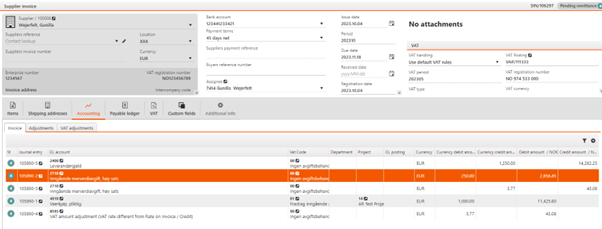Obliczenia opłaty za wymianę walut (agio)
W RamBase dostępne są dwa, opisane poniżej, procesy obliczania opłaty za wymianę walut. Pierwszy proces odbywa się podczas zamykania okresu przez użytkownika. Drugi jest wykonywany automatycznie przez RamBase podczas rejestracji płatności nabywców i dostawców.
Obliczanie opłaty za wymianę walut z okresów obrachunkowych (PAR)
Obliczenie agio w PAR spowoduje utworzenie 3 dokumentów ATR:
CUSBAL – opłata za wymianę walut w należnościach (AR).
SUPBAL – opłata za wymianę walut w zobowiązaniach (AP).
ACCBAL – opłata za wymianę walut we wszystkich innych kontach KG (nie rozrachunkach).
Dokumenty księgowania Księgi Głównej (ATR) dla CUSBAL i SUPBAL będą obliczane w oparciu o salda nabywcy i dostawcy w walutach obcych. Każda pozycja ATR będzie miała odwołanie do konta nabywcy/dostawcy i waluty. Kwota będzie obliczana na podstawie:
Dla wszystkich transakcji (CAT i SAT), które są otwarte na koniec bieżącego okresu, ale zostały zarejestrowane we wcześniejszych okresach. Opłata za wymianę walut (agio) zostanie obliczona na podstawie zmiany kursu walutowego z ostatniego okresu względem bieżącego okresu (kurs na ostatni dzień okresu), ponieważ te transakcje mają już obliczoną agio w ostatnim okresie.
Dla wszystkich transakcji (CAT i SAT), które są otwarte na koniec bieżącego okresu i zostały zarejestrowane w bieżącym okresie. Opłata za wymianę walut zostanie obliczona na podstawie zmiany kursu walutowego z dokumentu transakcji względem bieżącego okresu (kurs na ostatni dzień okresu).
Dokument ATR z typem transakcji ACCBAL będzie obsługiwał wszystkie inne konta KG (nie AR i AP), a agio zostanie obliczona w ten sposób:
Dla wszystkich transakcji (pozycje ATR), które zostały zarejestrowane we wcześniejszych okresach – Opłata za wymianę walut (agio) zostanie obliczona na podstawie zmiany kursu walutowego z ostatniego okresu względem bieżącego okresu (kurs na ostatni dzień okresu), ponieważ te transakcje mają już obliczoną agio w ostatnim okresie.
Dla wszystkich transakcji (pozycje ATR), które są zarejestrowane w bieżącym okresie – Opłata za wymianę walut zostanie obliczona na podstawie zmiany kursu walutowego z pozycji ATR względem bieżącego okresu (kurs na ostatni dzień okresu).
Przykład
Twoją walutą w systemie jest USD.
Masz CIN na 100 EUR.
W dniu zarejestrowania CIN (St:4) kurs wynosił 1,1. Oznacza to, że wartość tej CIN w walucie systemu wynosi (100 * 1,1) = 110 USD.
Rejestracja CIN generuje otwarte księgowanie w księdze należności na 110 USD.
W ostatnim dniu miesiąca kurs wynosił 1,2 (kurs okresu).
Na koniec miesiąca otwarte księgowanie zostało obliczone z uwzględnieniem agio na podstawie kursu okresu i kursu walutowego z dnia rejestracji. (100*1,2) - (100*1,1) = 10. Oznacza to zysk z tytułu opłaty za wymianę walut w wysokości 10 USD.
Jeśli CIN nie zostanie opłacona do końca następnego miesiąca, otwarte księgowanie zostanie obliczone z uwzględnieniem agio z poprzedniego kursu okresu względem nowego kursu okresu.
Nowy kurs okresu wynosi 1,4.
(100*1,4) - (100*1,2) = 20 Oznacza to zysk z tytułu opłaty za wymianę walut w wysokości 20 USD.
Właściwy raport: FRP > ACCBAL > Salda konta KG z obliczeń AGIO.
[en] Agio calculated during period closure in PAR (tab:agio) is posted to the general ledger account set up in the archive Account Defaults (ACD): Period Closure Agio.

Kursy walutowy dla płatności nabywcy i dostawcy
Sposób, w jaki RamBase obsługuje opłatę za wymianę walut (agio) w płatnościach, zależy od tego, czy agio jest skonfigurowana na koncie KG dla należności i zobowiązań. Jeśli opłata za wymianę walut nie jest stosowana, RamBase użyje kursu walutowego z dokumentu transakcji (co oznacza, że druga metoda opisana poniżej będzie zawsze używana).
Dla wszystkich faktur i not korygujących, które są połączone z płatnością i zostały zarejestrowane w okresie wcześniejszym niż płatność – Kurs walutowy z końca ostatniego okresu zostanie użyty do obliczenia wartości w lokalnej walucie, ponieważ te transakcje zostały już obliczone z uwzględnieniem opłaty za wymianę walut w ostatnim okresie.
Dla wszystkich faktur i not korygujących, które są połączone z płatnością i zostały zarejestrowane w tym samym okresie, co płatność – Kurs walutowy z dokumentu transakcji będzie używany do obliczania wartości w walucie lokalnej.
[en] If agio setting is not activated on GL Account for Account Receivables and Account Payables, exchange rate on payments will be handled this way:
[en] Regardless of if the invoice or credit note that is linked to a payment, is registered in an earlier period or in the same period as the payment, exchange rate from the transaction document will be used to calculate the value in local currency.
[en] ACD/PAYCURADJ - Currency deviations on payments
[en] GL account for Currency Deviations on Payments.
[en] Scenario Example:
[en] Payment Currency: NOK (Norwegian Krone)
[en] Invoice Currency: EUR (Euro)
[en] In this example:
[en] The sales invoice is for 12,500 EUR, registered on 2023.04.12 with an exchange rate (RATE) of 11.5435.
[en] The payment has a CURDATE of 2023.10.04, with a RATE of 11.4258.
[en] The exchange rate from the end of the previous period (2023.09.30) was 11.2535.
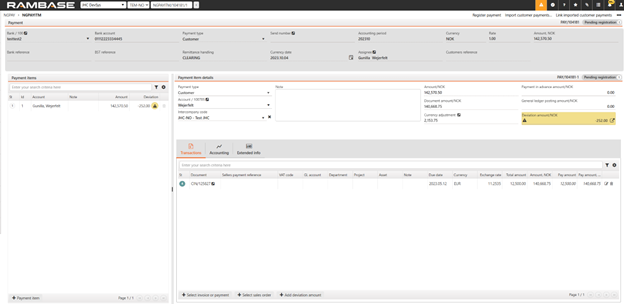
[en] Calculation of Currency Adjustment
[en] The Currency adjustment field reflects the currency deviation, calculated as follows:
[en] Determine the Payment Value in Local Currency (NOK): 12,500 EUR * 11.4258 (CURDATE RATE) = 142 822.50 NOK
[en] Determine the Invoice Value in Local Currency (NOK) Based on Previous Period RATE: 12,500 EUR * 11.2535 (2023.09.30 RATE) = 140 668.75 NOK
[en] Calculate the Currency Adjustment: 142 822.50 NOK – 140 668.75 NOK = -2 153.75 NOK
[en] The resulting currency adjustment of -2,153.75 NOK reflects the loss (or gain) due to exchange rate fluctuations between the invoice registration and payment dates.
[en] Inspecting the Currency Adjustment Field
[en] The Currency Adjustment field includes an Inspect feature:
[en] Clicking this allows you to view a detailed report of the currency loss or gain for the selected invoice and any credit notes linked to the payment.
[en] This report helps trace and verify how the deviation was calculated.
[en] GL Posting
[en] This currency deviation is automatically posted to the GL account configured in the Account Default (ACD) settings under Currency Deviation on Payments. Ensure the correct account is set up in the system to handle such postings.

[en] Explanation to the «Deviation amount»
[en] Differences due to different exchange rate in bank and RamBase. This is the difference between the value of the invoice based on RATE of the Currency date and what is received in bank. This deviation in «Deviation amount» could also contain of for example bank fees.
[en] Example Calculation:
[en] Invoice amount: 12 500
[en] Exchange rate on Currency date: 11.4258
[en] Invoice value in base currency: 12 500 ×11.4258 = 142 822.50
[en] Amount received in the bank: 142,570.50
[en] Difference (Deviation Amount): 142,570.50−142,822.50=−252
[en] The user must decide how to post this deviation to the General Ledger (GL). This process is performed manually. The accounting for the above payment will look like this:
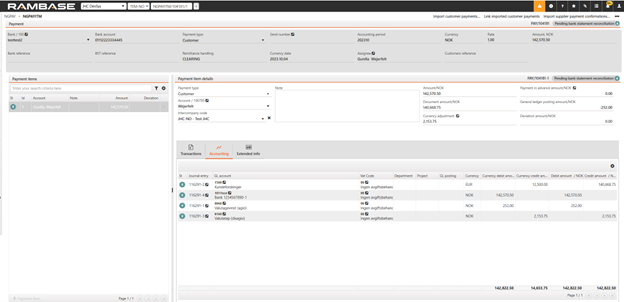
[en] ACD/EXCHANGE - Currency exchange
[en] GL account used when payments in foreign currency is posted to General Ledger:
[en] When payment and invoices/credit notes have different currencies, additional posting is made to balance out the GL postings.
[en] When a payment has many invoices and credits with different exchange rates, GL postings may not balance because of round offs on calculated average exchange rates. Additional posting for exchange rate difference is then made, if this difference is less than given in CompanySetting "MaxPaymentCurrencyDeviationOnLedgerSpecification".
[en] Example Impact on GL Account
[en] Scenario: Currency Deviations on Payments
[en] Calculate the invoice value from USD to the base currency (NOK):
[en] Based on the last day of the previous month: 6,600 USD×10.9139=72 031.74 NOK
[en] Based on Currency date: 6,600 USD×10.6225=70 108.50 NOK, Difference: 72,031.74−70,108.50=1 923.24 NOK
[en] Convert the NOK difference to EUR (PAY is for a Euro bank account): 1,923.24 NOK÷11.4258=168.32
[en] Postings to «ACC/8060»:
[en] When the amounts in USD and EUR are exchanged to NOK, two EUR postings are created because of the currency posting.
[en] Typically, only minor round-offs are posted to this account due to rounding of exchange rates and two-decimal resolution in GL.

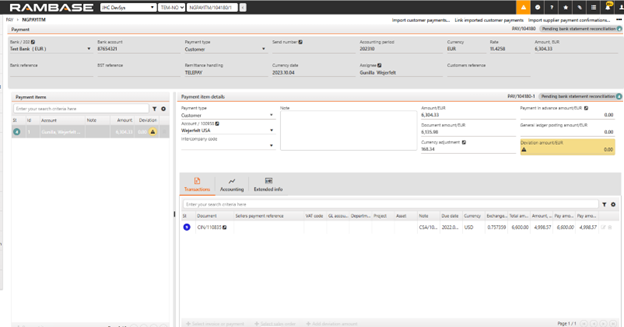
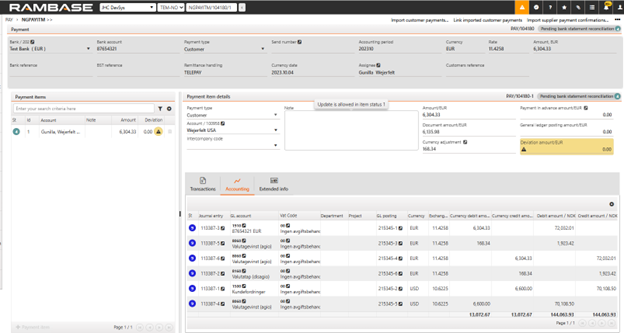
[en] The effect on ACC/8060 for this payment will be:

[en] ACD/VATRATEADJ - Vat rate adjustment on Invoices and Credit Notes
[en] This GL account is used when VAT adjustments are needed due to differences between the VAT rate and the exchange rate on invoices or credit notes.
[en] Example Scenario:
[en] An inbound invoice (SIN) has a VAT rate (VATRATE) that differs from the exchange rate (RATE):
[en] RATE: 11.4258
[en] VATRATE: 11.2535
[en] VAT amount: 250 EUR
[en] Calculation:
[en] Convert VAT amount using RATE: 250 EUR×11.4258=2 856.45 NOK
[en] Convert VAT amount using VATRATE: 250 EUR×11.2535=2 813.375 NOK
[en] Difference: 2,856.45−2,813.375=43.08
[en] Accounting Impact:
[en] This difference of 43.08 NOK is posted to ACD/VATRATEADJ.


[en] The accounting will look like this:
